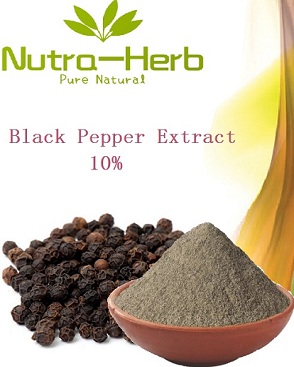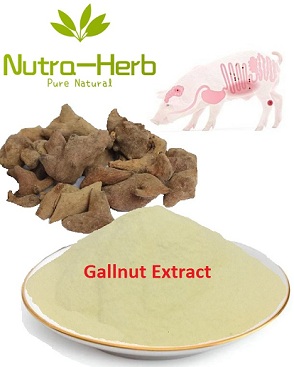- Plant-Based Protein
- Natural Plant Flavours
- Food and Dietary Supplement Ingredients
- Fruit Juice Powder
- Animal Nutrition Ingredients
- Water Soluble Ingredients
- Cosmetic Ingredients
- Unveiling the Therapeutic Potential of Rabdosia Rubescens: A Comprehensive Review
- What are the medicinal properties of Rabdosia Rubescens?
- Nutritional value of Orange Juice Powder compared to fresh orange juice.
- Processing Conditions and Nutritional Value of Orange Juice Powder
- Exploring the Versatility of Herbal Extracts in Food Flavors
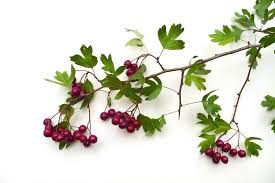
What are the health benefits of hawthorn leaf?
Welcome to our blog! Today, we are diving into the world of hawthorn leaf and uncovering its incredible health benefits. Whether you're a fan of herbal remedies or simply curious about natural alternatives, hawthorn leaf is definitely worth exploring.


Herbal Antibiotic-Forsythia suspensa Extract, Antimicrobial,used in livestock and poultry
Natural plant herb Forsythia suspense, has been used a potential non-antibiotic way to enhance anti-inflammatory and anti-microbial function, antioxidant status and performance in livestock. Forsythia suspense extract has strong immune enhancement functions. It can be used as an antibiotics substitute on performance, serum antioxidant status, fecal Escherichia coli content and intestinal morphology in poultry and livestock.
Background
The abuse or misuse of antibiotics in poultry's and livestock’ feed can result in bacteria resistant to antibiotics and lead to potential residues in animal products (such as pork, chicken) and in the environment, which may enhance the possibility of antibiotic-resistant infections in humans. Therefore, the European Union, the United States and many other countries have reduced or prohibited the use of antibiotics in animal feed and found appropriate alternatives for antibiotics.
Natural plant herbs can potentially serve as antibiotic substitutes. Currently, the practice of using traditional herbal medicine is gaining more attention worldwide in animal health care systems. The addition of traditional Chinese herbs, especially Forsythia suspense, has been used a potential non-antibiotic way to enhance anti-inflammatory and anti-microbial function, antioxidant status and performance in livestock. Forsythia suspense extract has strong immune enhancement functions. Forsythia suspense extract can be used as an antibiotics substitute on performance, serum antioxidant status, fecal Escherichia coli content and intestinal morphology in weaned piglets and other livestocks.
What you may get from us: If you're developing a feed additive that contains traditional Chinese medicine of Forsythia fruit (Forsythia suspensa (Thunb.) Vahl).I think you can find the information or products you need here.
Simple production process in our factory: After the plant is collected, It can be made straight powder. Or the raw material will be processed by solvent extraction, separation and purification, filtration, concentration, drying and other steps to form the final products. We may also design a prouction process based on your special requirements.
Through the physical and chemical processes, those compunds you don't want was removed, and the compunds preferred was accumulated. Which make the products achieve the best effects.
|
Forsythia Suspensa Straight powder or Forsythia Suspensa Extract |
||
|
Appearance |
Powder |
|
|
Color |
Brown |
|
|
Partical size |
Normally pass through 60mesh |
|
|
Pack size |
25 kg per paper drum |
|
|
Purity of active compunds |
6%Forsythiaside A and 0.5%Phillyrin (Forsythin) |
By HPLC |
|
For pricing or more information, please call 86 29 88444632 or send an email to Sales@nutraherbsource.com.
|
||
General Information
Botanical name: Forsythia suspensa (Thunb.) Vahl.
Common name: Forsythia fruit,Forsythiae Fructus, Lianqiao, Forsythiaside A, Phillyrin,Forsythin
Family: Oleaceae, olive family
Plant description
Shrubs. Branches spreading or pendulous; branchlets yellow-brown or gray-brown; internodes hollow. Leaves simple, sometimes 3-parted to 3-foliolate; petiole 0.8-1.5 cm, glabrous or sometimes pubescent; leaf blade ovate, broadly ovate, or elliptic-ovate, 2-10 × 1.5-5 cm, subleathery, glabrous or sometimes pubescent, or abaxially villous, especially along veins, base rounded to cuneate, margin serrate, apex acute. Flowers solitary or 2 to several in leaf axils. Pedicel 5-6 mm. Calyx lobes oblong, (5-)6-7 mm, ciliate. Corolla yellow; tube subequal to calyx lobes; lobes obovate-oblong or oblong, 1.2-2 cm. Pistil 5-7 mm in flowers with stamens 3-5 mm or ca. 3 mm in flowers with stamens 6-7 mm. Capsule ovoid to long ellipsoid, 1.2-2.5 cm × 6-12 mm, with scattered lenticels; stalk 0.7-1.5 cm.
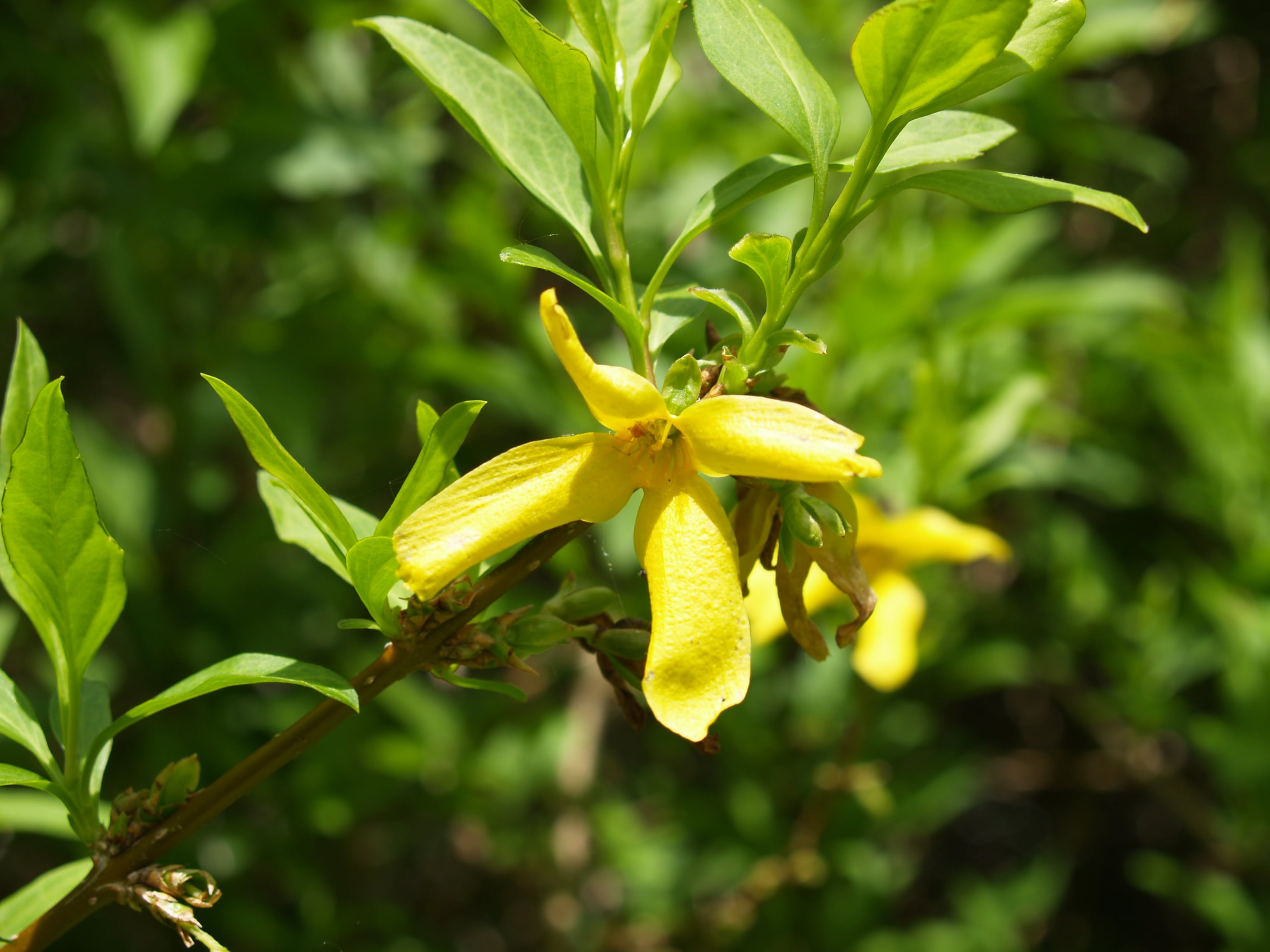
Chemistry
Lignans, such as phylligenin and pinoresinol, and their glucosides are major constituents of F. suspensa fruits, while the other species contain related compounds.Caffeic acid glycosides with variation in the number of sugars include forsythiaside, suspensaside and a number of forsythosides. The reduced cyclohexylethane derivatives rengyol, rengyoxide, and rengyolone5 and their glycosides (rengyosides A-C and forsythensides A and B) have been reported. The distribution of various phenolics among 7 different species of forsythia in leaves and fruits has been studied.The key bioactive compounds in Lianqiao are Forsythiaside A and Phillyrin (Synonym: Forsythin). Rutin is the major flavonoid of all 7 forsythia species. Caffeic ester glycosides from related genera of the Oleaceae have been compared.Several triterpenes have been isolated from the fruits as well.An HPLC assay for major forsythia phenolics has been published.The essential oil composition of the fruits has been studied.
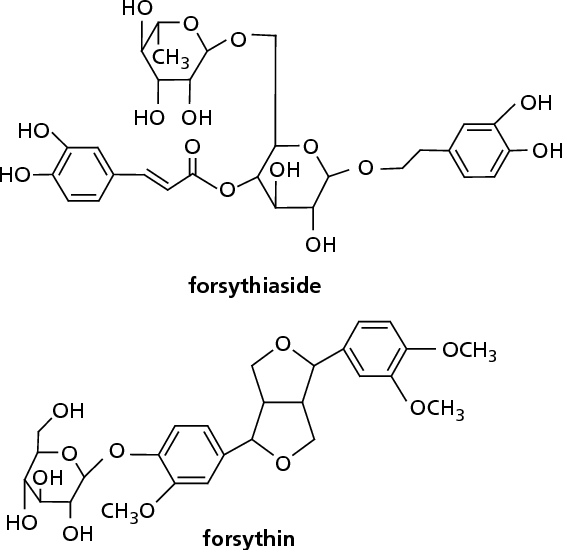
Medicinal use of Forsythia fruits (Lian Qiao)
Forsythia fruits are widely used in Chinese traditional medicine for antipyretic and anti-inflammatory activity in the treatment of bacterial infections and upper respiratory ailments. They are commonly combined with honeysuckle flower (Lonicera) and other ingredients. Forsythia fruits are also reputedly used as a diuretic and as a cardiovascular tonic.
Forsythia fruits (Lian Qiao) has been used in Chinese herbalism for over 4,000 years and is considered to be one of the 50 fundamental herbs. A bitter tasting pungent herb with an antiseptic effect, it is chiefly used to treat boils, carbuncles, mumps and infected neck glands. The fruit is a bitter astringent herb that stimulates the heart, nervous system and gall bladder. It contains vitamin P, which is used to strengthen capillaries. The fruit is also antidote, antiphlogistic, antitussive, diuretic, emmenagogue, febrifuge, laxative and tonic. It is used internally in the treatment of acute infectious diseases such as mumps, and also for tonsillitis, urinary tract infections allergic rashes etc. The fruit is harvested when fully ripe and is dried for use in decoctions. The plant has a similar action to Lonicera japonica and is usually used in combination with that species to achieve a stronger action. The flowers have a broad-spectrum antibacterial action, inhibiting the growth of Staphylococcus aureus, Shigella dysenteriae, haemolytic streptococcus, Pneumococcus, Bacillus typhi, Mycobacterium tuberculi etc. The plant is vermifuge, though the part used is not stated. The leaves are febrifuge and are also poulticed onto ulcerated glands and haemorrhoids. A decoction of the leaves and twigs is used in the treatment of breast cancer. The root is used in the treatment of cancer, colds, fever and jaundice.
Antimicrobial Actions
Antibacterial actions of forsythiaside and forsythin extracted from Forsythia suspensa were tested against E.coli, S.aureus and Pseudomonas aeruginosa. Forsythiaside showed high atibacterial activity based on the mean inhibitory concentration. i.e. the lowest concentraton which inhibited visible growth,against all three bacteria, and produced a lower mean inhibitory concentration than tetracycline against S.aureus. Forsythin showd no antibacterial activity against any of the three bacteria.
Anti-inflammatory Actions
Forsythia species have been demonstrated to have anti-inflammator actions in vitro, but few studies have examined inflammation using in vivo models. The anti-inflammatory effects of F. suspensa have been evaluated in the carrageenan-induced paw oedema model, and in the murine atopic dermatitis model. Rats prereated with Forsythia suspensa methanol extract showed a reduction in hindpaw volume following carrageenan injection compared with controls. Reduction in paw volume was evident three hours after carrageenan injection at dosage of 1g/kg, and one hour after injection with 3g/kg. No signs of toxicity were seen.
In the murine atopic dermatitis model. two studies have reported anti-inflammatory actions of Forsythia suspensa. In both studies, atopic dermatitis-like lesions were induced by topical application of Dermatophagoides farinae (mite) extract, applied twice per week for three weeks. In one study, Forsythia suspensa extract or fractions were applied daily starting seven days after commencement of Dermatophagoides farinae (mite) extract P. acnes colonisation.Importantly, histological examination showed no cell apoptosis with lauric acid. A further study evaluated liposomesas a delivery system for lauric acid. Lauric acid was found to com-pletely kill P. acnes in vitro.
Forsythia suspensa Extract Has the Potential to Substitute Antibiotic in Broiler Chicken
Some studies (Xu han et. al) show Forsythia suspensa extract has the potential to substitute for antibiotic in broiler chicken. First, a well-diffusion assay procedure and a 2-fold dilution method were used to determine the bacteriostatic activity of Forsythia suspensa Extract on Escherichia coli K88, staphylococcus aureus, and salmonella was assayed. An inhibitory effect of Forsythia suspensa Extract was observed on the growth of these bacteria. This effect seems to be dose depended, which disappeared after 25.00, 12.50, 1.56 mg/ml. Second, a 42-d trial with 252 broiler chickens (d 1, 38.7±1.1 g BW) was conducted to evaluate the effect of dietary supplementation of Forsythia suspensa Extract in broiler chicken. The feeding program consisted of a starter diet from d 1 to 21 and a finisher diet from d 22 to 42. Dietary treatments included were: i) NC: negative control fed a corn-soybean meal based diet; ii) PC: positive control group fed based diet with chlortetracycline; and iii) FC: a test group fed with 100 mg Forsythia suspensa Extract/kg diet. In the study growth performance did not differ among treatments during the starter period. However, dietary supplemental chlortetracycline and Forsythia suspensa Extract increased (p<0.05) average daily gain (ADG), average daily feed intake (ADFI) compared with NC during the finisher and overall phase. Apparent digestibility of calcium on d 21, digestibility of energy and calcium on d 42 of FC was greater (p<0.05) than NC. Moreover, cecal Escherichia coli counts for birds from FC were lower (p<0.05) than NC. Dietary Forsythia suspensa Extract supplementation also improved (p<0.05) villus height and villus height to crypt depth ratios in both duodenum and ileum and decreased (p<0.05) crypt depth in the duodenum. Duodenum villus height and villus height to crypt depth ratio in both duodenum and ileum from the FC group were also greater (p<0.05). Serum growth hormone and IGF-1 were not influenced by different treatments. Apparently, Forsythia suspensa Extract has the potential to substitute for antibiotic in broiler chicken.
Forsythia suspensa Extract can be used as a substitute Antibiotic in weaning piglets and other livestock.
Weaning is a stressful challenge for piglets because of the sudden changes of physiology and surrounding environment. These weaning stresses, usually presented as oxidative stress, may reduce antioxidant status, immunity and intestinal functions, which results in a reduction in feed intake, weight gain and health of piglets, as well as an increase in diarrhea incidence, morbidity and mortality. To overcome these post-weaning disorders caused by oxidative stress, Using of antibiotics as in-feed supplements after weaning may help reducing morbidity and mortality approximately 50% for weaned piglets. However, the abuse or misuse of antibiotics in piglets’ feed can result in bacteria resistant to antibiotics and lead to potential residues in animal products (such as pork) and in the environment, which may enhance the possibility of antibiotic-resistant infections in humans. Therefore, the European Union, the United States and many other countries have reduced or prohibited the use of antibiotics in animal feed and found appropriate alternatives for antibiotics.
Natural plant herbs can potentially serve as antibiotic substitutes. Currently, the practice of using traditional herbal medicine is gaining more attention worldwide in animal health care systems. The addition of traditional Chinese herbs, especially Coptis chinensis and Forsythia suspense, have been used a potential non-antibiotic way to enhance anti-inflammatory and anti-microbial function, antioxidant status and performance in livestock. The fruit or leaf extract of Forsythia suspensa Vahl (Oleaceae) could be widely used as Chinese medicine to help treat some infections, including pharyngitis, nephritis, febrile erysipelas, ulcers, tonsillitis, gonorrhea and acute respiratory syndrome. Studies have demonstrated that lignan, phenethyl alcohol glycoside, volatile oil as well as pentacyclic triterpenoids are the major active compounds of Forsythia suspensa extract, which has proven to have anti-oxidant, anti-bacterial, anti- inflammatory and anti-allergy effects.Forsythia suspense extract has strong antioxidant properties and immune enhancement functions. Studies also show Forsythia suspense extract can enhance performance by modulating intestinal permeability, antioxidant status and immune function in animals combined with chito-oligosaccharide or berberine. Forsythia suspense extract (200 mg/kg) supplementation as a substitute for chlortetracycline can help improve performance, nutrient digestibility, serum antioxidant capacity and intestinal morphology as well as reduce the content of Escherichia coli in the feces of weaned pigs.Forsythia suspense extract can be used as an antibiotics substitute on performance, serum antioxidant status, fecal Escherichia coli content and intestinal morphology in weaned piglets.
Dosage:
Forsythia suspense extract (200 mg/kg) supplementation as a substitute for chlortetracycline can help improve performance, nutrient digestibility, serum antioxidant capacity and intestinal morphology as well as reduce the content of Escherichia coli in the feces of weaned pigs.
- Prev:Fenugreek Extract,phytogenic Feed addtive,improve growth performance,feed conversion for poultry
- Next:Nutrappetite-1,Herbal formula,Improve Growth Performance and Feed Conversion of Poultry



